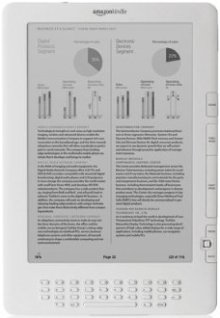Amazon super-sizes the Kindle
May 6, 2009 — by Eric Brown — from the LinuxDevices Archive — 4 views [Updated, 10:35 AM] — Amazon announced a new version of its Linux-based e-book reader, with a 9.7-inch screen and native PDF support. The “Kindle DX” sports a thin (1/3-inch) profile, 4GB of storage, and a 1200 x 824 display that rotates from portrait to landscape modes.
[Updated, 10:35 AM] — Amazon announced a new version of its Linux-based e-book reader, with a 9.7-inch screen and native PDF support. The “Kindle DX” sports a thin (1/3-inch) profile, 4GB of storage, and a 1200 x 824 display that rotates from portrait to landscape modes.
(Click for larger view of the Kindle DX)
The new big-screen Kindle DX also has a larger 10.4 x 7.2 x 0.4-inch profile and weight (18.9 ounces), as well as a higher price tag ($490) than the Kindle 2 electronic book (e-book), which shipped in early March. By comparison, the Kindle 2 measures 8 x 5.3 x 0.36 inches, weighs 10 ounces, and costs $360.
The Kindle DX also boosts flash storage from 1.4GB to 4GB, of which 3.3GB is available for user storage. As a result, the device can hold up to 3,500 books, periodicals, and documents, says Amazon.

The Kindle DX slims down to 0.4 inches
Like the Kindle 2, the Kindle DX's screen offers the latest E-ink gray-screen technology with 16 shades of gray. However, it also provides the larger 9.7-inch size (up from six inches) and higher 1200 x 824 resolution (compared to 600 x 800). It also adds accelerometers to let the device auto-rotate like a smartphone, automatically switching from portrait to landscape as the device is turned.
The new built-in PDF reader answers a major wish-list item among the growing legions of Kindle-readers. The new native PDF support means that users can now read their own PDF documents, not just the documents provided by Amazon.


Kindle DX
Other features appear to be similar to the Kindle 2, which also communicates via the free 3G Amazon Whispernet service based on Sprint's EVDO network. The network is said to deliver a book in less than a minute. Like the Kindle 2, the Kindle DX improves on the original Kindle e-book reader with longer battery life, and the addition of a micro-USB 2.0 connector. The SD slot available with the original Kindle was removed with the Kindle 2, and still appears to be missing.
Amazon did not list the processor used by the Kindle DX, but the Kindle 2 (pictured below, at right) moved up to an ARM11-based Freescale i.MX31 system-on-chip (SoC) clocked to 532MHz. The older Kindle ran a Marvell PXA250 chip.
 Kindle 2 |
Additional Kindle DX features that were introduced with the Kindle 2 include a new text-to-speech “read-to-me” feature, which lets users switch back and forth between reading and listening, and a New Oxford American Dictionary. As before, the Kindle offers an MP3 player and a web browser, and supports a wide variety of text and image files. Amazon now claims to offer over 275,000 books, with New York Times Best Sellers and new releases typically priced at $10.
The Kindle DX has not yet appeared on Amazon's open-source download page, but should show up when the device finally ships this summer. The page includes the GPL'd Linux sources, sans .config files, for both the Kindle 1 and Kindle 2. The Kindle 2's stack appears to be based on a Linux 2.6.22 kernel, along with U-Boot, Alsa, Busybox, and various other popular open source software programs.
The long overdue e-book revolution
Aside from having the advantage of linking to Amazon's huge media collection, one of the Kindle's chief appeals was its adoption of the low-power “electronic paper” display technology sourced from E Ink. Previously, the only major e-book reader to provide the technology was the Sony PRS 500. After the launch of the Kindle, a number of other e-book readers have appeared, almost all of them using the same 6-inch, 800 x 600 gray-scale E-Ink display as the Kindle 2.



Hanlin eReader, Bookeen Cybook and Foxit eSlick (l),
(Click any for details)
Most of the competing e-book readers are also Linux-based, including the Hanlin eReader V3, the Bookeen Cybook, and the recent Foxit eSlick.
Availability
According to Amazon, the Kindle DX will be available during the summer for $490. Further information may be found on the company's product page, here, says Amazon.
A report on Amazon's Kindle DX announcement by Nicholas Kolakowski in our sister publication eWEEK may be found here. The story details several new publishing partnerships with major newspaper and textbook publishers announced by Amazon.
This article was originally published on LinuxDevices.com and has been donated to the open source community by QuinStreet Inc. Please visit LinuxToday.com for up-to-date news and articles about Linux and open source.